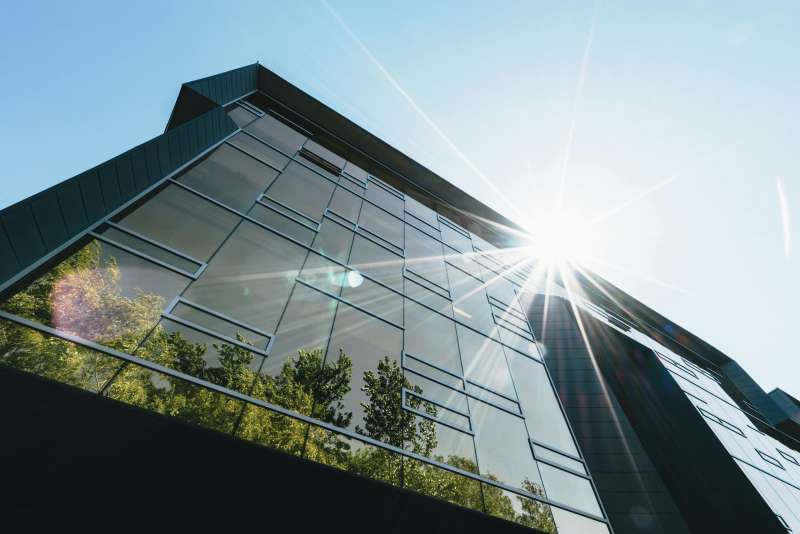Green Buildings: Smart Solutions for Sustainable Construction
Published on: May 12, 2025
Green Buildings: Smart Solutions for Sustainable Construction
In the contemporary era of rapid urbanization and environmental awareness, green buildings have emerged as a transformative approach to sustainable construction. These structures are not merely architectural innovations but represent a holistic philosophy that integrates intelligent technologies with environmentally conscious design. Green buildings aim to reduce the ecological footprint of the built environment while enhancing the quality of life for their occupants. By employing advanced systems for energy, water, and waste management, these buildings set new standards for efficiency, comfort, and sustainability.
Principles of Green Building Design
The core principles of green building design revolve around minimizing negative impacts on the environment and maximizing resource efficiency. This involves careful consideration of location, orientation, materials, and technology integration. Site selection is crucial, as it determines the building’s exposure to natural elements and its accessibility to public transport and amenities. Optimal orientation allows for maximum use of natural light and passive solar heating, reducing reliance on artificial lighting and climate control systems.
Material selection is another fundamental aspect. Green buildings prioritize the use of renewable, recycled, and locally sourced materials, which reduces transportation emissions and supports regional economies. Intelligent design also considers the entire lifecycle of materials, from extraction and processing to disposal or reuse. The integration of technologies such as building automation systems, energy-efficient lighting, and advanced insulation further enhances the sustainability of these structures.
Smart Energy Management in Green Buildings
One of the defining features of green buildings is their sophisticated approach to energy management. Smart building technologies enable real-time monitoring and control of energy consumption, allowing for significant reductions in operational costs and greenhouse gas emissions. Building Management Systems (BMS) are central to this effort, linking heating, ventilation, air conditioning (HVAC), lighting, and security systems into a unified platform.
Solar panels are a common sight on green buildings, harnessing renewable energy from the sun to supply electricity or heat water. Photovoltaic systems can be integrated into rooftops, facades, or even windows, generating clean energy on-site and reducing dependence on fossil fuels. Some buildings also employ wind turbines or geothermal systems, tapping into local renewable resources for further energy savings.
Energy-efficient appliances and LED lighting contribute to lower electricity consumption. Automated lighting systems use sensors to adjust illumination based on occupancy and daylight levels, ensuring that energy is used only when and where it is needed. Smart thermostats and zone-based climate control enable precise management of indoor temperatures, optimizing comfort while minimizing waste.
- Energy monitoring platforms provide real-time data on usage patterns, enabling building managers to identify inefficiencies and implement corrective measures.
- Demand response programs allow buildings to adjust their energy consumption during peak periods, supporting grid stability and reducing costs.
- Battery storage systems can store excess renewable energy for use during periods of low generation or high demand.
Water Conservation and Management
Water scarcity is a growing concern in many regions, making efficient water management a critical component of green building design. Intelligent systems for water conservation include rainwater harvesting, greywater recycling, and low-flow fixtures. These technologies not only reduce water consumption but also lower utility bills and lessen the burden on municipal infrastructure.
Rainwater harvesting systems collect and store precipitation from rooftops, which can be used for irrigation, flushing toilets, or even potable purposes with proper treatment. Greywater recycling systems capture wastewater from sinks, showers, and laundry, treating it for reuse in non-potable applications. These systems can reduce a building’s water demand by up to 50% in some cases.
Low-flow faucets, dual-flush toilets, and water-efficient appliances further minimize consumption. Smart irrigation systems use weather data and soil moisture sensors to deliver water only when necessary, preventing overwatering and conserving resources. Leak detection systems monitor plumbing networks for signs of leaks or inefficiencies, enabling prompt repairs and preventing water loss.
Waste Reduction and Recycling
Green buildings adopt a comprehensive approach to waste management, focusing on reduction, reuse, and recycling throughout the construction and operational phases. During construction, strategies such as modular building, prefabrication, and precise material ordering help minimize waste generation. Leftover materials are often recycled or repurposed, diverting them from landfills.
Within the building, waste management systems facilitate the separation and collection of recyclable materials. Composting facilities may be integrated to process organic waste generated by occupants. Digital platforms can track waste streams and provide feedback on recycling rates, encouraging occupants to participate in sustainability efforts.
Some green buildings employ on-site waste-to-energy systems, converting organic waste into biogas or electricity. This not only reduces landfill use but also provides a renewable source of energy. Policies promoting zero waste and circular economy principles are increasingly prevalent in green building certifications and standards.
Eco-Friendly Materials and Construction Techniques
The choice of materials plays a pivotal role in the sustainability of green buildings. Eco-friendly materials such as bamboo, recycled steel, reclaimed wood, and low-VOC (volatile organic compound) paints are favored for their minimal environmental impact. These materials are often sourced from suppliers with transparent and responsible production practices.
Green construction techniques prioritize methods that reduce energy use, emissions, and waste. Prefabrication and modular construction allow for precise manufacturing in controlled environments, reducing on-site waste and improving quality. Green roofs and living walls are increasingly popular, providing insulation, absorbing rainwater, and enhancing biodiversity.
Insulation is a key factor in maintaining indoor comfort and reducing energy demand. Advanced insulation materials, including aerogels and vacuum-insulated panels, offer superior thermal performance. High-performance windows with low-emissivity coatings and triple glazing further enhance energy efficiency by minimizing heat loss and solar gain.
Permeable paving materials and green landscaping help manage stormwater runoff, reducing the risk of flooding and erosion. These features also create pleasant outdoor spaces for occupants, contributing to well-being and community engagement.
Indoor Environmental Quality and Occupant Well-Being
Green buildings are designed not only for environmental performance but also for the health and comfort of their occupants. Indoor environmental quality (IEQ) encompasses factors such as air quality, lighting, acoustics, and thermal comfort. High IEQ has been linked to improved productivity, reduced absenteeism, and enhanced occupant satisfaction.
Natural ventilation systems promote the circulation of fresh air, reducing reliance on mechanical ventilation and improving indoor air quality. Operable windows, atriums, and ventilation shafts facilitate airflow, while filtration systems remove pollutants and allergens. Low-emission materials and finishes limit the release of harmful chemicals, creating a healthier indoor environment.
Daylighting strategies maximize the use of natural light, reducing the need for artificial lighting and enhancing occupant well-being. Large windows, skylights, and light shelves distribute daylight deep into interior spaces. Studies have shown that access to natural light can improve mood, concentration, and overall health.
Acoustic comfort is addressed through sound-absorbing materials, strategic space planning, and noise-reducing technologies. Thermal comfort is maintained through advanced HVAC systems, high-performance glazing, and effective insulation. Personal control over lighting, temperature, and ventilation allows occupants to tailor their environment to their preferences.
- Biophilic design elements, such as indoor plants and natural materials, foster a connection to nature and support mental health.
- Flexible spaces accommodate a variety of activities, promoting collaboration, creativity, and adaptability.
- Universal design principles ensure accessibility for people of all ages and abilities.
Smart Building Technologies and Automation
Intelligent building technologies are at the heart of green building innovation. Automation systems integrate sensors, controllers, and software to optimize building performance and occupant experience. These systems collect and analyze data on energy use, indoor conditions, and occupancy patterns, enabling continuous improvement and adaptive management.
Key technologies include:
- Internet of Things (IoT) devices for real-time monitoring and control of lighting, HVAC, and security systems.
- Artificial intelligence (AI) algorithms that predict energy demand, optimize system settings, and identify maintenance needs.
- Smart meters and dashboards that provide occupants and managers with actionable insights into building performance.
- Automated shading and lighting systems that respond to sunlight and occupancy, reducing energy use and enhancing comfort.
Building Information Modeling (BIM) is widely used in the design and construction of green buildings. BIM enables architects, engineers, and contractors to collaborate on digital models, identifying opportunities for efficiency and sustainability. Digital twins, virtual replicas of physical buildings, facilitate ongoing performance monitoring and predictive maintenance.
Security and access control systems in green buildings use smart cards, biometrics, and mobile apps to enhance safety and convenience. Integration with emergency response systems ensures rapid and coordinated action in case of fire, flood, or other incidents.
Certifications and Standards for Green Buildings
Multiple certification systems and standards guide the development of green buildings worldwide. These frameworks establish criteria for energy efficiency, water conservation, material selection, and indoor environmental quality. Achieving certification demonstrates a commitment to sustainability and can enhance the value and marketability of a property.
Prominent green building certifications include:
- Leadership in Energy and Environmental Design (LEED): Developed by the U.S. Green Building Council, LEED is one of the most widely recognized certification systems, with projects in over 180 countries.
- BREEAM (Building Research Establishment Environmental Assessment Method): Originating in the UK, BREEAM assesses buildings for environmental impact, health, and innovation.
- WELL Building Standard: Focused on occupant health and well-being, WELL evaluates factors such as air, water, nourishment, light, fitness, comfort, and mind.
- Green Star: An Australian rating system that assesses the environmental impact of buildings, fitouts, and communities.
Compliance with these standards often requires third-party verification and ongoing performance monitoring. Many governments and municipalities offer incentives for certified green buildings, including tax credits, grants, and expedited permitting.
Economic and Social Benefits of Green Buildings
Investing in green buildings delivers significant economic and social advantages. Although initial construction costs may be higher due to advanced technologies and materials, operational savings from reduced energy and water use often offset these expenses within a few years. Green buildings typically command higher rental rates and property values, reflecting their desirability and lower operating costs.
Occupants of green buildings benefit from improved health, comfort, and productivity. Enhanced indoor air quality, natural light, and thermal comfort contribute to well-being and reduce absenteeism. Organizations that prioritize sustainability and employee wellness often experience higher retention rates and stronger brand reputation.
Green buildings also support local economies by creating demand for sustainable materials, technologies, and skilled labor. Community engagement is fostered through shared spaces, green infrastructure, and educational initiatives that promote environmental stewardship.
Challenges and Future Directions
Despite their many benefits, green buildings face several challenges. High upfront costs, limited awareness, and regulatory barriers can hinder adoption. The complexity of integrating multiple systems and technologies requires specialized expertise and coordination among stakeholders.
Ongoing research and development are addressing these challenges. Advances in materials science, automation, and renewable energy are making green building solutions more affordable and accessible. Policy frameworks and financial incentives are encouraging broader adoption, while education and training programs are building the necessary workforce.
The future of green buildings lies in the integration of smart technologies, renewable energy, and circular economy principles. Net-zero and positive energy buildings, which generate more energy than they consume, are becoming increasingly feasible. Urban planning is evolving to prioritize green infrastructure, resilient design, and community well-being.
As cities continue to grow and environmental pressures intensify, green buildings offer a path toward a more sustainable, healthy, and equitable built environment. Their widespread adoption will play a pivotal role in shaping the future of construction and urban living.










